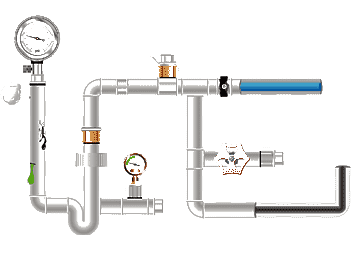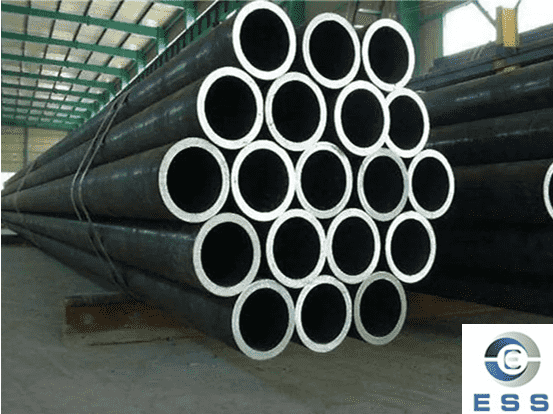ISO 3183 Standard
ISO 3183 Standard is a technical standard
published by the International Organization for Standardization (ISO) for steel
pipes used in pipeline transportation systems for the oil and gas industry.
This standard specifies the manufacturing
requirements, chemical composition, mechanical properties, test methods, and
quality system for seamless
steel pipes (SMLS) and welded
steel pipes (ERW,
HFW, LSAW, SSAW).
The standard is divided into two product
specification levels:
PSL 1 (Product Specification Level 1):
General service level with broader requirements.
PSL 2 (Product Specification Level 2): High-end
service level, suitable for more demanding operating conditions, such as high
pressure, high temperature, and acidic environments.
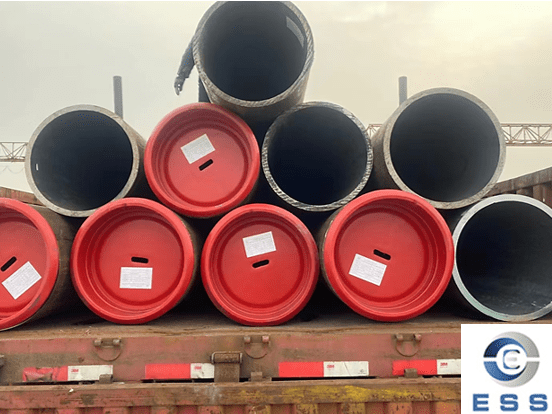
ISO 3183 Pipe Specification
|
Standard
|
ISO 3183
|
|
Procedure
|
ERW/HFW, SMLS, SSAW, LSAW
|
|
Dimensions
|
10.3mm – 2134mm
|
|
1/8″ – 84″
|
|
DN6 – DN400
|
|
Thickness
|
1.7mm – 52mm
|
|
SCH 5S, SCH10, SCH20, SCH30, SCH40, STD,
XXS, SCH60, SCH100, SCH120, SCH140, SCH1
|
|
Unit Length
|
3 – 18 mtrs
|
|
Steel Grade
|
Gr. A, X56, X90, Gr. B, X60, X100, X42,
X65, X120, X46, X70, X52, X80
|
|
Surface Coating
|
Black lacquer coating, Varnishing,
Oiling, Hot Dip Galvanizing
|
|
FBE, 2PP, 3PP, 2PE, 3PE
|
|
End Type
|
Plain, Bevelled, Threaded, Grooved,Shouldered
|
|
Joint Method
|
Fitting, Flange,
Coupling, Clamp, Pipe Shoulder, Welding
|
|
Pipe Machining
|
Welding, Bending, Hole Drilling,
Punching, Swaging, Tapering, Flaring, Expanding
|
ISO 3183 Seamless Pipe Size
|
ISO 3183 Pipe Size: Permissible Specified
Outside Diameter and Specified Wall Thickness
|
|
Specified Outside Diameter
D
mm (in.)
|
Specified Wall Thickness
t
mm (in.)
|
|
Special Light Sizes a
|
Regular Sizes
|
|
≥ 10.3 (0.405) to < 13.7 (0.540)
|
—
|
≥ 1.7 (0.068) to ≤ 2.4 (0.094)
|
|
≥ 13.7 (0.540) to < 17.1 (0.675)
|
—
|
≥ 2.2 (0.088) to ≤ 3.0 (0.118)
|
|
≥ 17.1 (0.675) to < 21.3 (0.840)
|
—
|
≥ 2.3 (0.091) to ≤ 3.2 (0.125)
|
|
≥ 21.3 (0.840) to < 26.7 (1.050)
|
—
|
≥ 2.1 (0.083) to ≤ 7.5 (0.294)
|
|
≥ 26.7 (1.050) to < 33.4 (1.315)
|
—
|
≥ 2.1 (0.083) to ≤ 7.8 (0.308)
|
|
≥ 33.4 (1.315) to < 48.3 (1.900)
|
—
|
≥ 2.1 (0.083) to ≤ 10.0 (0.394)
|
|
≥ 48.3 (1.900) to < 60.3 (2.375)
|
—
|
≥ 2.1 (0.083) to ≤ 12.5 (0.492)
|
|
≥ 60.3 (2.375) to < 73.0 (2.875)
|
≥ 2.1 (0.083) to ≤ 3.6 (0.141)
|
> 3.6 (0.141) to ≤ 14.2 (0.559)
|
|
≥ 73.0 (2.875) to < 88.9 (3.500)
|
≥ 2.1 (0.083) to ≤ 3.6 (0.141)
|
> 3.6 (0.141) to ≤ 20.0 (0.787)
|
|
≥ 88.9 (3.500) to < 101.6 (4.000)
|
≥ 2.1 (0.083) to ≤ 4.0 (0.156)
|
> 4.0 (0.156) to ≤ 22.0 (0.866)
|
|
≥ 101.6 (4.000) to < 168.3 (6.625)
|
≥ 2.1 (0.083) to ≤ 4.0 (0.156)
|
> 4.0 (0.156) to ≤ 25.0 (0.984)
|
|
≥ 168.3 (6.625) to < 219.1 (8.625)
|
≥ 2.1 (0.083) to ≤ 4.0 (0.156)
|
> 4.0 (0.156) to ≤ 40.0 (1.575)
|
|
≥ 219.1 (8.625) to < 273.1 (10.750)
|
≥ 3.2 (0.125) to ≤ 4.0 (0.156)
|
> 4.0 (0.156) to ≤ 40.0 (1.575)
|
|
≥ 273.1 (10.750) to < 323.9 (12.750)
|
≥ 3.6 (0.141) to ≤ 5.2 (0.203)
|
> 5.2 (0.203) to ≤ 45.0 (1.771)
|
|
≥ 323.9 (12.750) to < 355.6 (14.000)
|
≥ 4.0 (0.156) to ≤ 5.6 (0.219)
|
> 5.6 (0.219) to ≤ 45.0 (1.771)
|
|
≥ 355.6 (14.000) to < 457 (18.000)
|
≥ 4.5 (0.177) to ≤ 7.1 (0.281)
|
> 7.1 (0.281) to ≤ 45.0 (1.771)
|
|
≥ 457 (18.000) to < 559 (22.000)
|
≥ 4.8 (0.188) to ≤ 7.1 (0.281)
|
> 7.1 (0.281) to ≤ 45.0 (1.771)
|
|
≥ 559 (22.000) to < 711 (28.000)
|
≥ 5.6 (0.219) to ≤ 7.1 (0.281)
|
> 7.1 (0.281) to ≤ 45.0 (1.771)
|
|
≥ 711 (28.000) to < 864 (34.000)
|
≥ 5.6 (0.219) to ≤ 7.1 (0.281)
|
> 7.1 (0.281) to ≤ 52.0 (2.050)
|
|
≥ 864 (34.000) to < 965 (38.000)
|
—
|
≥ 5.6 (0.219) to ≤ 52.0 (2.050)
|
|
≥ 965 (38.000) to < 1422 (56.000)
|
—
|
≥ 6.4 (0.250) to ≤ 52.0 (2.050)
|
|
≥ 1422 (56.000) to < 1829 (72.000)
|
—
|
≥ 9.5 (0.375) to ≤ 52.0 (2.050)
|
|
≥ 1829 (72.000) to < 2134 (84.000)
|
—
|
≥ 10.3 (0.406) to ≤ 52.0 (2.050)
|
|
NOTE: Standardized values for specified
outside diameter and specified wall thickness of pipe are given in ISO 4200
[7] and ASME B36.10M[8]
|
|
a. Pipe having the combination of
specified outside diameter and specified wall thickness is defined as special
light size pipe; other combinations given in this table are defined as
regular size pipe.
|
ISO 3183 PSL1 Seamless Pipe: Chemical
Composition
|
Chemical Composition For Pipe With t≤25
mm(0.984in)
|
|
Steel Grade
|
Mass Fraction,based
upon heat and product analyses
%maximum
|
Carbon Equivalent
% max
|
|
–
|
C
|
Si
|
Mn
|
P
|
S
|
V
|
Nb
|
Ti
|
Other
|
CEIIW
|
CEPcm
|
|
Seamless and welded pipe
|
|
L245NE or BNE
|
0.18
|
0.4
|
1.2
|
0.025
|
0.015
|
–
|
–
|
–
|
–
|
0.42
|
0.25
|
|
L290NE or X42NE
|
0.19
|
0.4
|
1.2
|
0.025
|
0.015
|
0.06
|
0.05
|
0.04
|
–
|
0.42
|
0.25
|
|
L360NE or X52NE
|
0.22
|
0.45
|
1.4
|
0.025
|
0.015
|
0.1
|
0.05
|
0.04
|
–
|
0.43
|
0.25
|
|
L415NE or X60NE
|
0.23
|
0.45
|
1.4
|
0.025
|
0.015
|
0.1
|
0.05
|
0.04
|
–
|
As agreed
|
As agreed
|
|
Seamless pipe
|
|
L360QE or X52QE
|
0.18
|
0.45
|
1.5
|
0.025
|
0.015
|
0.05
|
0.05
|
0.04
|
–
|
0.42
|
0.25
|
|
L415QE or X60QE
|
0.18
|
0.45
|
1.7
|
0.025
|
0.015
|
0.09
|
0.06
|
0.05
|
–
|
0.43
|
0.25
|
|
L450QE or X65QE
|
0.18
|
0.45
|
1.7
|
0.025
|
0.015
|
0.1
|
0.06
|
0.07
|
–
|
0.43
|
0.25
|
|
L485QE or X70QE
|
0.18
|
0.45
|
1.8
|
0.025
|
0.015
|
0.11
|
0.06
|
0.07
|
–
|
0.43
|
0.25
|
|
L555QE or X80QE
|
0.18
|
0.45
|
1.9
|
0.025
|
0.015
|
0.11
|
0.07
|
0.07
|
–
|
As agreed
|
As agreed
|
Mechanical Requirement of ISO 3183 Seamless
Pipe
|
Steel Grade
|
Pipe body of SMLS and welded pipes
|
Weld seam of HFW,SAW
and COW pipes
|
|
Yield Strength
Rt0.5
MPa(psi)
|
Tensile Strength
Rm
MPa(psi)
|
Ratio
Rt0.5/Rm
|
Elongation
Af
%
|
Tensile Strength
Rm
MPa(psi)
|
|
min
|
max
|
min
|
max
|
max
|
min
|
min
|
|
L245NE or BNE
|
245
(35500)
|
440
(63800)
|
415
(60200)
|
655
(95000)
|
0.8
|
22
|
415
(60200)
|
|
L245ME or BME
|
245
(35500)
|
440
(63800)
|
415
(60200)
|
655
(95000)
|
0.85
|
22
|
415
(60200)
|
|
L290NE or X42NE
L290ME or X42ME
|
290
(42100)
|
440
(63800)
|
415
(60200)
|
655
(95000)
|
0.85
|
21
|
415
(60200)
|
|
L360NE or X52NE
L360ME or X52ME
|
360
(52200)
|
510
(74000)
|
460
(66700)
|
760
(110200)
|
0.85
|
20
|
460
(66700)
|
|
L360QE or X52QE
|
360
(52200)
|
510
(74000)
|
460
(66700)
|
760
(110200)
|
0.88
|
20
|
460
(66700)
|
|
L415NE or X60NE
L415ME or X60ME
|
415
(60200)
|
565
(81900)
|
520
(75400)
|
760
(110200)
|
0.85
|
18
|
520
(75400)
|
|
L415QE or X60QE
|
415
(60200)
|
565
(81900)
|
520
(75400)
|
760
(110200)
|
0.88
|
18
|
520
(75400)
|
|
L450QE or X65QE
|
450
(65300)
|
570
(82700)
|
535
(77600)
|
760
(110200)
|
0.9
|
18
|
535
(77600)
|
|
L450ME or X65ME
|
450
(65300)
|
570
(82700)
|
535
(77600)
|
760
(110200)
|
0.87
|
18
|
535
(77600)
|
|
L485QE or X70QE
L485ME or X70ME
|
485
(70300)
|
605
(92100)
|
570
(82700)
|
760
(110200)
|
0.9
|
18
|
570
(82700)
|
|
L555QE or X80QE
L555ME or X80ME
|
555
(79800)
|
675
(97900)
|
625
(90600)
|
825
(100200)
|
0.9
|
18
|
625
(90600)
|
ISO 3183 Seamless Pipes: Material and
Manufacturing Process Requirements
For seamless pipes, PSL2 grade requires
continuous casting or rolling, followed by piercing, hot rolling/cold drawing
processes.
1. Chemical Composition Control
The sulfur and phosphorus contents in the
chemical composition must not exceed 0.015% and 0.025%, respectively.
The corresponding carbon equivalent (CEIIW) ≤ 0.43%, and cold crack susceptibility index (Pcm) ≤ 0.25.
2. Corrosion Resistance and Crack
Resistance Requirements
The standard specifically emphasizes the
control of susceptibility to HIC (hydrogen-induced cracking) and SSC (sulfide
stress corrosion cracking), requiring a crack susceptibility rate (CSR) of less
than 2% as tested by NACETM0284 standard.
ISO 3183 Seamless Pipes: Mechanical
Property Requirements
Depending on the steel grade, the yield
strength of seamless pipes must meet clearly defined gradient requirements.
Taking L245M (equivalent to L245 in GB/T9711) as an example, its minimum yield
strength is 245 MPa, tensile strength is 415-760 MPa, and
elongation is ≥20%. For high-grade steel pipes such as
X80, the standard stipulates that a Charpy impact test at -20℃ is required, with each specimen absorbing no less than 40 J of
energy.
ISO 3183 Seamless Pipes: Dimensional and
Tolerancing Control
Outer diameter tolerances are divided into
ordinary grade (±0.75%) and high-precision grade (±0.5%), and wall thickness tolerances are dynamically adjusted
according to the D/t ratio.
For example, when D/t ≤ 20, the wall thickness tolerance is 15%/-12.5%. This stringent
dimensional control ensures the assembly accuracy of the pipe circumferential
weld and reduces the risk of stress concentration.
ISO 3183 Seamless Pipes: Special
Performance Test Requirements
Unlike general steel pipe standards, ISO
3183 specifies several specialized tests for the special operating conditions
of oil and gas transportation:
1. Full Flattening Test
For PSL2 seamless steel pipes, no cracks
should appear when flattened to a distance of 2/3 of the outer diameter of the
pipe.
2. Guided Bending Test
Verifies the plastic deformation capacity
of the steel pipe substrate and weld.
3. Corrosion Test
Includes a 96-hour salt spray test and a
HIC immersion test, requiring a crack length ratio (CLR) ≤ 15% for the sample section.
4. Non-destructive Testing
100% ultrasonic testing (UT) for
longitudinal defects, and eddy current testing (ET) or magnetic flux leakage
testing (MFL) for transverse defect screening.
ISO 3183 Seamless Pipes: Quality Control
and Certification System
ISO 3183 adopts a dual quality management
mechanism of manufacturer qualification certification + production process
control. Manufacturers should possess the following quality system:
1. Raw material incoming inspection records
(including spectral analysis reports).
2. Archived heat treatment process curves
(normalizing temperature deviation must be controlled within ±20°C).
3. Calibration certificates for online
automatic testing equipment (UT equipment calibrated weekly).
4. Third-party supervision and inspection
reports (such as factory audits by DNV GL or TÜV).
Comparison with Relevant Standards
Compared to ASTM
A106 (Carbon steel seamless pipes for high-temperature applications) or
EN 10216 (Seamless steel pipes for pressure applications), ISO 3183 has
distinct features in the following aspects:
1. Environmental adaptability
Added requirement for -60°C low-temperature impact in Arctic regions.
2. Crack arrest performance
Specifies the 85% shear area threshold for
DWTT (Drop Weight Tear Test).
3. Weldability indicators
Carbon equivalent CEI ≤ 0.43%, cold crack sensitivity coefficient Pcm ≤ 0.25.
4. Marking and traceability
Requires each steel pipe to be
laser-engraved with information including standard number, steel grade, furnace
number, and dimensions.
FAQ
1. What are the main differences between ISO
3183 PSL1 and PSL2?
PSL2 is more stringent than PSL1 in terms
of chemical composition, impact performance, non-destructive testing, and
document traceability, making it suitable for high-risk transportation
scenarios.
2. What is the relationship between ISO
3183 and API
5L?
The two standards are highly consistent.
API 5L is essentially equivalent to the ISO 3183 standard and is commonly used
in oil and gas pipeline projects in North America.









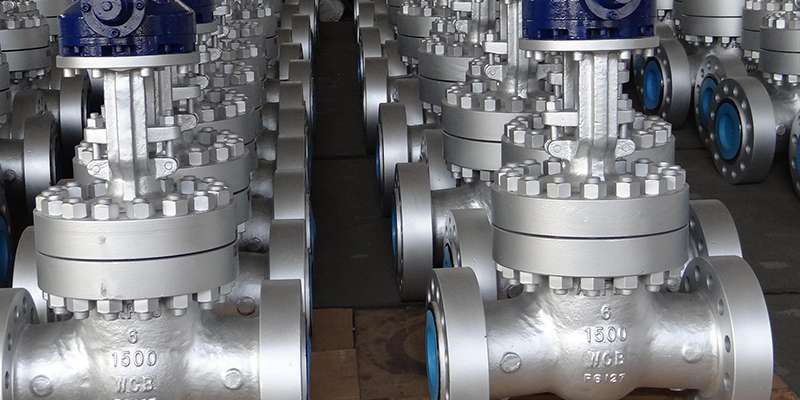



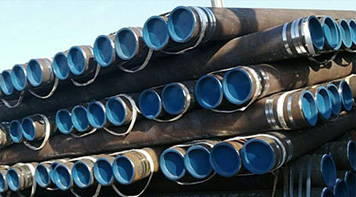 Eastern Steel Manufacturing Co.,Ltd not only improve product production and sales services, but also provide additional value-added services. As long as you need, we can complete your specific needs together.
Eastern Steel Manufacturing Co.,Ltd not only improve product production and sales services, but also provide additional value-added services. As long as you need, we can complete your specific needs together.
